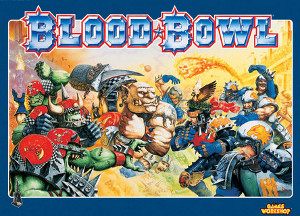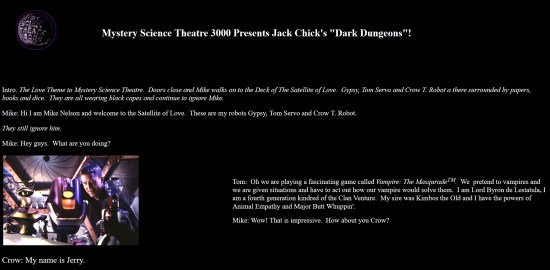
Total Votes: 22
Description
How can you describe Blood Bowl? The game is the attempt of an English publishing company to merge American Football with the Warhammer Fantasy world. The idea is to score as many touchdowns as you can in your allotted 16 turns while preventing your opponent from scoring in his turns; if you are playing in a league, then you want to get as many "star points" for your players, while trying to kill or seriously injure your enemy's players.
So what's different about the third edition? The old first edition was basically the Warhammer Fantasy rules grafted onto this topic. The second edition brought us new rules, but had some problems -- "the game had a distressing tendency to get bogged down in long-winded 'blocking battles' where nothing very much happened," as designer Jervis Johnson explains in his Designer's Notes. And so the third edition has been slimmed down and polished, to keep the game fast-paced and short.
The Teams
Each player is the Coach of a team, which can either be taken from one of the provided rosters or designed from scratch (purchased with 1,000,000 gold pieces). Each team can consist of up to 16 players, though only 11 can be on the field at one time.
For those who want to make their own teams, six races are provided – humans and orcs (the playing pieces which come with the game), as well as elves (both dark and high), dwarves, and skaven (rats).
Once a Coach has chosen the race for his team, he can select from the 4 types of players which that race has. For instance, human players are either linemen, catchers, throwers, or blitzers (running backs). Linemen are the cheapest to recruit, while blitzers are the most expensive. Each type of player has its stats (movement, strength, agility, and armor), skills (for instance, orc throwers have the Pass and Sure Hands skills), and recruitment cost. Some types also have recruitment limits – for instance, you can't have more than 4 orc blitzers on the same team.
Though most of the players start off generic – that is, there's no difference between the six or so linemen on a starting orc team – coaches can also hire Star Players. These special players are experienced players who act as free agents, available for hire to a set number of eligible races. There are four Star Players in Blood Bowl, each with a card describing his abilities.
The Game
The playing field is gridded off into squares. Only one figure is allowed per square. In the center is the Line of Scrimmage. At the ends of the board are the end zones; along the sides of the boards are the wide zones.
The match starts with a kickoff. The players flip a cardboard "coin" to determine which teams kicks the ball. The kicking team places its players on the field first, on its side of the Line of Scrimmage. At least three players must be placed on the line, and only two players can be put in each wide zone. After the kicking team is set, the receiving team places its players.
Next, the coach of the kicking team picks a target point and rolls for the kick. The game has begun!
The first turn belongs to the receiving team. (There are 8 turns per half, or 16 turns in the full game.) He can now move his players one by one, completing all actions by one before continuing to the next. The actions allowed include running, blocking (player doesn't move, and tries to knock down an adjacent player), blitzing (running and blocking, but only one player can do this per turn), and passing (includes running, but also limited to one player per turn).
As a player takes his actions, he will need to make various kinds of die rolls. For instance, if he moves away from an adjacent enemy player, he'll need to Dodge to avoid falling down. Most of these rolls are based on the players' stats, with modifiers for situation (usually a -1 penalty for each adjacent enemy player). When making a pass, a plastic template is used to measure distance; rolls must be made both to throw and to catch the ball.
Whenever a player falls down, he might be injured. The gamut of possibilities ranges from stunned (lose a turn) and knocked out (miss part or all of the game) to serious injury or even death. Some players (i.e. most skaven) are more likely to be injured than others (i.e. tough dwarves). By the way, it's a good idea to avoid the sidelines, for a player who gets knocked off the field by a block is at the mercy of the crowd (resulting in an automatic injury!).
A player's turn is over once he's moved all of his men. More often, however, the turn comes to a crashing halt due to a turnover – this occurs when one of his players fails a die roll (for instance, trying to Dodge and falling down instead).
Each Coach has a limited number of re-roll counters. These can be spent to avoid a turnover, allowing one (and only one) new die roll. Certain skills also allow players to take a re-roll of the dice for their specialties (Pass, for instance, gives you a re-roll when trying to make a pass).
Play continues as a series of turns until either a touchdown occurs or the half comes to an end. To make a touchdown, a player must carry the ball into the end zone (if he is pushed across the line and falls down, it doesn't count.) To start the game back up, another kick is made. (This is also when new players can come off the bench.) And so it goes.
At the end of the 16-turn match, the Coach with the most touchdowns wins. If there is a tie, the game enters Sudden Death and up to eight more turns are played – the first to score a goal, wins. If Sudden Death ends without a victory, the winning Coach is determined by die roll.
The Extra Rules
Blood Bowl also includes a set of optional rules – known as the Extra Rules – which add flavor to the game. These rules include:
| Hand-offs | Allows one player to give the ball to an adjacent player |
|---|---|
| Interceptions | Your opponent has a chance to grab your pass |
| Fumbles | Passers drop the ball on a roll of "1" |
| Assists | Allows players to gang up when blocking |
| Throwing | Lets unusually strong players throw other players |
| Going For It | Gives players a chance for extra movement |
| Fouls | Kicking downed players is profitable, if you don't get caught |
| Weather | Roll at start, lasts for duration of the match |
| Random Events | From cheering fans to a riot |
The Extra Rules also explain several new skills, as well as Secret Weapons ("illegal" weapons which certain Star Players carry).
The rules for designing Blood Bowl teams are also presented in this part of the rulebook. In addition to buying players, Coaches may spent their money to buy Re-Roll Counters, Fan Factors (i.e. team popularity), assistant coaches and cheerleaders (useful during certain random events).
Supplements
Death Zone

This is basically the supplement for those who want to set up Blood Bowl leagues. The boxed set consists of a 34-page rulebook, 18 Star Player cards, 116 Special Play cards, reference cards and counters, cardboard trophies, and a new roster pad.
The New Teams. With Death Zone, six new teams (races) are added to Blood Bowl -- Goblins, Halflings, Wood Elves, Undead, Chaos, and Chaos Dwarves.
- Goblins are weak but cheap, and have a number of inexpensive Star Players with Secret Weapons (bombs, chainsaws, and pogo sticks). There is only one player type. Both Goblins and Halvlings are Stunty (a bonus when dodging).
- Halflings are even cheaper than Goblins, as well as slower and even more lightly armored. Like Goblins, they can be thrown. Can hire the Treeman Star Player to hurl them. Only one player type.
- Wood Elves differ from the other elves in sacrificing armor for speed. The Wardancer player type can attempt to leap over opposing players. Can recruit the Treeman.
- The Undead team has five player types (Skeletons, Zombies, Ghouls, Wights and Mummies), most of whom regenerate. The dead are neither quick nor agile, but the Mummy has a Mighty Blow which can seriously injure his opponents. Can recruit a Vampire Star Player. An Undead Coach is a Necromancer, and can Raise Dead once per match to turn a dead player on the opposing team into a Zombie for his team.
- The Chaos team is made up of Beastmen and Warriors. Horns give Beastmen a blocking bonus when blitzing. Chaos players with sufficient Star Points may receive physical mutations. Eligible for five of the Star Players (including most of the Goblins).
- The Chaos Dwarves come in only one type (Blockers), but for company they have their hobgoblin slaves (also one player type). Blockers are the same as Longbeards on the standard Dwarf team. Hobgoblins have the advantage of being cheap. There are two good Chaos Dwarf Star Players.
New Extra Rules. Besides the rules to cover the new Star Players (and their skills and secret weapons), Coaches may now hire Wizards and Apothecaries. Ordinary wizards can cast one spell (fireball, zap!, or lightning bolt) per match. Some teams may hire special wizards. (My favorite is the halfling Master Chef, whose cooking odors allow the halflings to "steal" re-roll counters from their enemies.) The Apothecary gets one chance per match to negate an injury.
League Rules. A league consists of at least four teams willing to play each other through a series of games. In league play, players receive Star Player (i.e. experience) points which can qualify the player for new skills. Serious injuries have also been individualized, so that a player might suffer anything from a pinched nerve to a fractured skull. Each team must also calculate its Team Rating, based on its current players.
Before a league match begins, Coaches have the chance to hire freebooters (regular or Star Players who play on a per game basis). Fan Factors count towards the Gate (i.e. how many fans attend the match, which later helps determine the winnings). A Coach whose team has a lower Team Rating than his opponent may receive bonus Special Play cards and Star Player points.
After the match, each team works out its winnings, Fan Factors may be won or lost, new players can be recruited, and players with Star Points might qualify for new skills.
There is no set schedule for matches among league teams. Instead, teams can play each other at any time, so long as the same two teams do not play each other more than twice in a row. In addition, the League Commissioner can organize tournaments during the season, allowing teams to compete for the trophies which come with this supplement.











